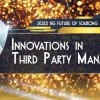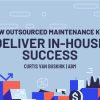In Part I of this article we provided insight into the key steps and success factors associated with the process of re-engineering a corporate real estate services organization. In Part II, we shift the focus to strategic sourcing of real estate and facilities services: supplier pre-qualification, bid strategy, RFP development and administration, contract negotiation and transition management.
- Supplier Pre-Qualification
- Bid Strategy
- Request for Proposal/Solution/Partner Development
- Bid Administration
- Contract Development and Negotiation
- Transition Management
- What is the company profile?
- What is their product profile?
- What is their commitment to the industry?
- Are they willing to meet your needs?
- A brief overview of your company and its intention to source a particular good or service;
- Instructions on how and when to respond as well as contact information and a timeline;
- A list of questions focusing on the provider’s ability to deliver the service needed; and,
- Any relevant attachments that the potential bidder must agree/adhere to or sign in order to be considered as a potential bidder.
- Assess the information provided and determine which providers will be included in the next phase of the sourcing process.
2. Bid Strategy
A bid strategy includes the following elements:
- The list of pre-qualified suppliers;
- A carefully determined approach to service alignment;
- A well-defined bid process; and,
- The pricing structures and contract framework.
The bid itself should include six basic components. Although organizations call the process of obtaining a bid many different things, the most common is "Request for Proposal" (RFP). A properly constructed RFP ensures that all responses are comprehensive, easily evaluated and reasonably comparable. Your RFP should be sure to address the following:
-
Administration: Specify exactly how you want the responses submitted. Require the bidders to respond to the questions in the order presented, include the original question and utilize the same numbering scheme.
-
Logistics: Clarify your right to use the information submitted in any way you choose and that bidders bear the costs associated with preparing the response. Specify how bidders will interact with existing contractors or sub-contractors, employees and the bid team.
-
Business Context: Include a clear delineation of your company, the component of the organization that will be impacted, the intent of the RFP, and the specifications and volume of information that will enable the bidder to develop a comprehensive solution. Some organizations opt for a pre-RFP yellow-pad session that allows the bidders to present their capabilities and ask questions.
-
Approach/Solution: Craft the questions about "how" the bidder will provide services so they may be easily evaluted. Focus on one concept at a time. Ask for supporting documentation and exhibits. If a particular response must be submitted in a specific format to facilitate analysis, provide a template.
-
New Ideas: Provide the bidders an opportunity to make suggestions, offer modified approaches, or demonstrate innovation and creativity. However, limit their opportunity to be creative to a single stand-alone section.
-
Service Agreement: Include the actual agreement within the RFP and require the bidders to comment on their willingness to accept your terms and conditions and any modifications they would require.
You must decide how you will distribute the RFP. Over time, eSourcing tools have become more sohisticated and some may be able to handle intricate services RFPs. Depending on the tool, you may be limited to conducting a reverse auction on the pricing component or just distributing the questions and gathering the responses electronically. The more sophisticated tools also allow you to score responses and turn the winning response into a contract.
4. Bid Administration
Bid administration can be relatively straight forward and simple, yet it is fraught with potential pitfalls. The goal is to ensure the bid runs smoothly and that the team has sufficient, valid information to award the contract. Successful bid administration consists of three primary factors: a solid process, excellent communication and consistent application.
- The scope and service level expectations;
- The desired outcome and goals of the relationship;
- The governance model;
- Specific pricing details;
- Defined limitation of liability; and,
- Indemnification.
e. Tenaciously Guard Key Provisions Affecting Financials:
Pay special attention to limitation of liability, indemnification and insurance. Although of limited consequence when the relationship is healthy, each has the potential to increase the financial exposure of the owner substantially while decreasing the financial exposure of the supplier.
f. Address Termination and Exit Strategy:
After a lengthy sourcing process, it is often difficult to think about "the end" of the relationship. However, this is the only time you will have the power to negotiate your rights upon termination. Termination rights should be negotiated for conditions of cause and/or convenience (without cause), and address issues that might include:
- Financial penalties;
- Transition of data, personnel, systems and processes;
- Rights of ownership of intellectual property and items developed by reimbursable staff; and,
- Rights to hire critical staff at termination (at no cost to you), transferable to your designee.
g. Incorporate Strong Performance Measures and Incentives:
Key performance measures (KPIs) and service level agreements (SLAs) serve as vital elements in the management of supplier performance. You can manage supplier performance most effectively when the provider's performance drives total compensation. After the contract is executed, performance management will become part of the governance structure that we will discuss in Segment III.
6. Transition Management
Whether you decide to reengineer internally or outsource, a well-conceived, well-executed transition plan is critical. Many well-intentioned reengineering and outsourcing initiatives have stumbled or failed in transition. Five critical components include:
a. Establish a Dedicated Transition Team:
The transition team should include representatives from key areas such as Human Resources, Information Technology, Procurement and Finance, in addition to the operational management team. Allocate a sufficient number of resources to the transition team and enlist "dedicated leadership" whenever possible.
b. Utilize a Formal Process:
Conduct an in-depth kick-off meeting with all team members to review and confirm the project goals, implementation strategies, critical success activities, sequencing of events and target milestone dates. The transition should be completed "swiftly," but not be rushed. Clearly document roles and responsibilities of all parties, agree on deliverables and timeframes and schedule regular weekly or bi-weekly meetings.
c. Embrace Continuous Improvement:
Establish a mechanism to identify service improvements and opportunities to lower costs. Place a strong emphasis on training and employee retention. Set aggressive improvement targets in customer service, quality and cost savings and engage everyone in your operation in the development of those targets.
d. Abolish the Use of Old Practices:
If after the successful planning, communication and implementation of the "new model" the departmental staff, customers or suppliers continue to use "old" practices, the success of the project will be greatly diminished, or could be considered a total failure. Ensure business controls are put in place to prohibit the use of practices and procedures that relate to the prior environment.
e. Measure Performance and Report:
You have established a clear baseline of your operation, competition, customers and industry. Be equally well versed in the vision, operations and financial aspects of your new model. Understand the underlying drivers to your costs, operate your department with an entrepreneurial mindset and be able to clearly articulate your value proposition. Share the impact of objectives as they are met. Communicate progress frequently, and use a consistent format. Use multiple methods for communicating the same message, and repeat it often.







